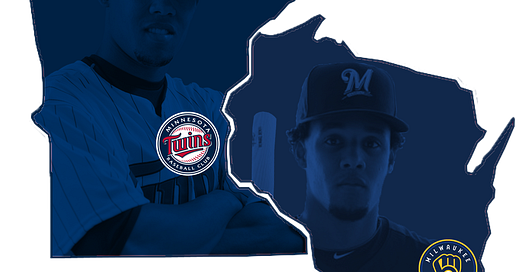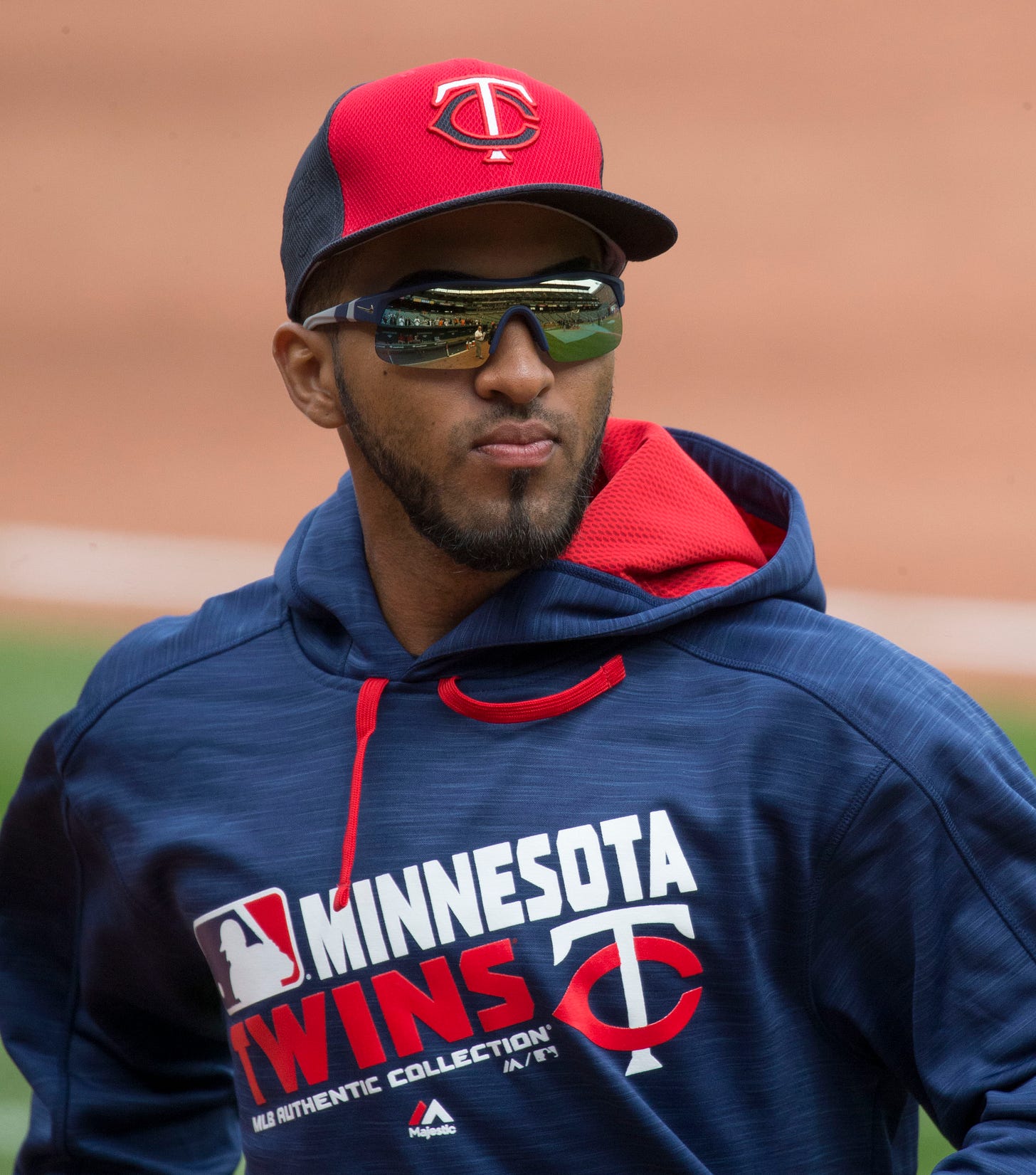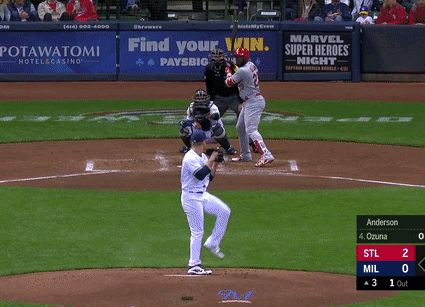To tender or not to tender, that is the question
We also take a look back at the 2016 top-rated Brewers farm system and see what happened since then
Happy December, children.
We have finally reached the day everyone has long been looking forward to: the non-tender deadline! I first typed that previous sentence rather facetiously because who actually looks forward to the non-tender deadline. Then I realized that it will almost certainly be the single-busiest and most newsworthy day of the baseball off-season for lots of teams, which sent soul-crushing nerves throughout my body while also in a really baseball nerdy way getting my hopes up for some actual transactions.
The deadline is 7 p.m. ET. We don’t know exactly how things will go, but there’s a pretty strong general feeling that a bunch of teams are going to choose to not pay a bunch of players, which is the opposite of fun.
Now that I’ve written a glowing endorsement for being a baseball fan, let’s converse.
(Oh, and also the Dinos won the KBO championship. Go Dinos. )
The case for (and against) Eddie Rosario
~Jake and Tom
On this, the second day of December or whenever you are reading this, fine reader—erm, juror—Tom Dierberger and I, Jake Schultz, will attempt to argue a case. This is a case of much importance to this newsletter’s constituents and may very well alter the fabric of the team in question, the Minnesota Twins. I don’t see Derek Falvey or Thad Levine on this jury but we cannot rule it out. Stop laughing. They might read this, you never know.
The matter at hand, gentlepeople of the jury, is the case of one Eddie Rosario and whether or not the Minnesota Twins should non-tender the longtime Twin ahead of the Dec. 2 non-tender deadline.
As a prosecuting baseball attorney, I’m here to explain why it’s time for Alex Kiriloff SZN [aside to court reporter: that’s pronounced “season”] and for the veteran left fielder to shuffle along to the next city by way of a non-tender. Arguing for the defense is my longtime friend and now eternal enemy, Tom Dierberger. He represents the Keep Ed In Minnesota group, organized on behalf of the aforementioned Eddie Rosario
We each will present a few thou
ghts, with room for rebuttal. In accordance with longstanding judicial tradition, we ask that your deliberations take place via half-baked arguments via Twitter.
I, the prosecution, will begin:
Contract situation
JS: When I went to Baseball Argument Law School, the one thing they always taught me was to avoid speaking kindly of the defense. I’m going to do it anyway, though. Eddie Rosario is a fine ballplayer! The argument for non-tendering him is not necessarily about his ability. It’s about his contract.
Rosario is set to earn about $11 million in 2021, according to Spotrac. That number is tied for 23rd among all outfielders. That doesn’t seem like a whole lot, but that’s tied with Miguel Sano for second-most on the Twins. Rosario isn’t close to the second-best player on the Twins. He’s not even the second-best outfielder.
Rosario is a high-wire act offensively, working as the definition of a boom-or-bust bat. He’s averaged just over 19 homers in his six big league seasons, punctuated by a 32-homer outburst in 2019. Let’s look at that 2019 season, though: He bopped a career-high home run total, yes, but he walked just 3.7% of the time, leading to a .300 on-base percentage, tying him for seventh-worst in the bigs that season. His power outburst was impressive, no doubt, but that was all that buoyed him to a perfectly average 103 wRC+. In other words, he’s a cold streak at the plate away from becoming a total liability offensively.
That’s to say nothing about his defense, where he’s almost worse than a zero. At least with someone like Nelson Cruz out there (which, can you imagine??), you expect very little range. Rosie, meanwhile, hurts himself with foolish mistakes. In 2019, he ended up with the ninth-lowest defensive runs saved total among all outfielders (-8).
Rosario has his positives, sure, but $11 million for an average outfielder is too high.
TD: Objection, your honor! You want to talk about contracts? First of all, you bring up the fact that Rosario isn’t the second-best player on the Twins. Well, he’s one heck of a lot closer to being the second-best player than Sano, who led the big leagues in K% and posted a 99 wRC+ this summer. Meanwhile, Rosario has proven he can consistently produce again and again. Plus, Rosario stays healthy. While his outfield mates in the Twins clubhouse struggle mightily to roll out of bed in the morning without suffering a concussion, Rosario has been a steady presence. He played 57 of 60 contests this summer and has suited up for 137+ games every season since 2017.
And his boom-or-bust bat? That, my friend, is a perk. There is no one more capable of leading the Twins on a 12-game surge than Rosario. Take the month of May 2018, for example, when he batted .368/.388/.615 with six dingers, 11 doubles and 21 RBI. Or May 2019 when he logged a .313/.325/.500 slash line with six moonshots and 25 RBI. Again, he’s capable of singlehandedly fueling the Twins’ offense. In a long, 162-game season, successful teams need to be able to ride players like Rosario for weeks at a time. His boom-or-bust bat is an asset, not a negative.
Lastly, his defense. Rosario ranked fourth among American League left fielders with a SABR defensive rating of 1.1 in 2020. He’ll likely never win a Gold Glove award, but with Byron Buxton running around center field, the Twins don’t need another star glove -- just a solid one. That’s what Rosario brings.
Alex Kirilloff exists
JS: And so does Trevor Larnach, Gilberto Celestino and Brent Rooker. In other words, the Twins have other options.
Kirilloff, who made a brief appearance in the 2020 playoffs, is the No. 3 prospect for the Twins, according to FanGraphs, and he’s very much ready for the big leagues. He’s crushed each level of the minors that he’s faced, despite battling with injuries. Assuming the minor leagues are back up and running in 2021, God willing, Kirilloff may need a month or so to get going before a big-league call up, but he’s not far, as proven by his .283/.343/.413 statline in Double-A. He needs to tap into some of the power that many prospect analysts see for him, but he could be a contributing player right away.
Larnach is No. 2 among all Twins prospects according to FanGraphs and is in a similar boat to Kirilloff. Larnach has raked in the minors, logging a 148 wRC+ in 2019 as a lefty bat. He’s no defensive star, though Byron Buxton patrolling center field should help him.
Throw in Rooker, who did well in his seven-game debut before he fractured his forearm in 2020. Like Larnach, Rooker is a power-first college bat with a long line of above-average hitting at every minor league stop.
This all doesn’t even include Jake Cave or utility guys like Willians Astudillo or Travis Blankenhorn.
The Twins don’t need every one of those guys to peak in order to replace Rosario. It’s likely that an average rookie season from Kirilloff or Larnach would cover Rosario’s output at about 5% of the cost, with the added benefit of minor league options.
TD: There is no denying Kirilloff is The Real Deal. He is. Any 23-year-old who gets called up in October, makes his major-league debut in an elimination playoff game and manages to notch a hit has a pair of metallic cojones. But Kirilloff’s future is in right field, not left field. He’s not a great defender, and he’s not a natural fit to replace Rosario. Of the 279 minor-league games Kirilloff started, just 3.2% of them were in left field. Sure, he’s an athlete and can learn multiple positions. But, look, the Twins want to contend for a World Series next season. Even though Kirilloff’s cojones are too large to qualify as carry-on luggage, as we discussed above, it’s not a guarantee that he’ll be ready for a full-time role in 2021. Other than the playoff tilt against Houston, Kirilloff hasn’t appeared in an actual baseball game since 2019. If we learned anything from the 2020 season, it’s the importance of depth on a roster. Having Kirilloff start the 2021 season in the minor leagues and get called up early to serve as the Twins’ fourth outfielder is a much better role for the youngster than to throw him to the wolves on a roster competing in the suddenly competitive AL Central.
But let’s look beyond just next year in the Twins’ outfield. Dare I say it, Buxton will be due for arbitration once again after next season, and he’ll become an unrestricted free agent following the 2022 campaign. Do the Twins really want to sign Buxton to a long-term deal? A player who hasn’t appeared in more than 87 contests since 2017? If I learned anything from my financial advisor, it was to make sound, smart long-term decisions with my cheddar. Signing Buxton to a big contract would be a risk -- and probably one the Twins should be wary of taking with all the outfield depth in the organization. Sign Rosario to a deal for next season, and -- who knows -- maybe bring him back for a few more years -- and you know what you’re going to get. Picture the Twins’ outfield in 2022. Max Kepler in center, Rosario in left and Kirilloff in right, with prospects Rooker and Larnach providing depth as they prove their worth in the big leagues. Now that’s a winning formula.
JS: I demand a mistrial, your honor. The defense just committed multiple offenses against Byron Buxton. I’m not sure if it’s slander, libel or perjury but this aggression will not stand, man.
He lies
JS: He says he’s 6-foot-1. I’m sorry, but no he’s not. I have no evidence to support this. All I know is that man is not 6-foot-1.
TD: He very much is 6-1. The only lie in the history of media guides is the 2012 Park Center baseball handbook that stated Jake’s prowess in fantasy baseball. We all know that’s not true.
JUDGE: Thomas! Unnecessary.
TD: Apologies, your honor. In conclusion, I hope the jury will hear my argument to keep Rosario in Minnesota. In a season where the Twins desperately need to sell tickets (COVID-19 vaccine permitting, of course), Rosario is a fan-favorite. His swagger puts butts in seats. Rosario has been an opening day starter in left field for Minnesota every year since 2016. Imagine refusing to give this player, who has hit the second-most dingers for the Twins over the last five seasons, the pay day he certainly deserves. Rosario’s electric bat should have a place in Minnesota’s lineup in 2021 -- and for years to come.
Some deep (?) thoughts
~Curt
I found myself in a bit of a predicament over the weekend.
I was reminded by a tweet that the Brewers in 2016 had the highest-rated farm system in the majors by MLB.com. This led to a thought that popped up in my head: given that fact, along with the ‘16 big league team featuring controllable, productive players such as Jonathan Villar, Domingo Santana, Zach Davies, Junior Guerra and Chase Anderson, was winning only one playoff series from that point forward...underwhelming?
I’m not going to delve into the answer to that (it’s “no”...probably...I think), but it was a rather puzzling question that made me reevaluate a lot of things I thought I thought about baseball and did lead further down a rabbit hole regarding expectations we place on prospects and farm systems as a whole and what we define as a “successful” prospect.
Take that 2016 group touted as the best in the bigs. My initial reaction would be to say that those prospects, on the aggregate, have underperformed. That’s largely because, at the top, there have been plenty of disappointments.
But have they?
Let’s start with the players who didn’t meet our arbitrary definitions of success relative to their status as prospects.
Orlando Arcia and Lewis Brinson were top-15 prospects in all of baseball and the two highest-rated players in the system. Corey Ray (No. 3 in the system) has yet to reach the majors. Luis Ortiz (No. 5) pitched three games for the Orioles over two years after being traded and is now a free agent. Phil Bickford (No. 6), well, that’s a long story. Brett Phillips (No. 8) has had a moment every little leaguer dreams of but has only been worth 2.6 WAR in parts of four seasons. Gilbert Lara, Cody Ponce, Marcos Diplan, Jorge Lopez, Kody Medeiros, Lucas Erceg and Ryan Cordell are all players who were in the top 20 and have seemingly fallen off. (One of the few Orioles games I watched with any form of intent this past season was Lopez’s first outing with the team after being claimed off waivers from Kansas City. The hope in the Orioles announcers’ voices when talking about things like how he had some of the biggest upside on the roster and could be a key future rotation piece will stick with me forever. Poor Baltimore fans.)
Prospects, though, don’t pan out as we would have hoped more often than they do. We, for whatever reason, tend to remember those “what-if” tales more than the successes. That 2016 class still produced plenty of major league talent, even if the players we rated most highly at the time largely didn’t turn out like we expected. At the top, still, it had an elite, elite reliever in Josh Hader (No. 4), long-term solid big leaguer Trent Grisham (No. 7) and potential multi-win players Isan Diaz (No. 10) and Mauricio Dubon (No. 11). The run deeper down in the system is arguably more impressive. Devin Williams (No. 20), Corbin Burnes (No. 21) and Fred Peralta (No. 22) is a helluva consecutive run that low on a prospect list. Brandon Woodruff (No. 26), Tyrone Taylor (No. 27) and Mario Feliciano (No. 29) weren’t much farther down.
That’s two all-stars and, if there had been a 2020 All-Star Game, that number is likely five, with Grisham, Williams and Burnes cracking the list. Those five have been worth 19.3 fWAR, with none appearing in the majors prior to the midway point of 2017 and only Hader having a defined big league role before summer of 2018.
It’s not the 2015 top-ranked Cubs system, which contained a core featuring Kris Bryant, Kyle Schwarber, Carl Edwards Jr. and Addison Russell that helped deliver a World Series, as well as long-term big league contributors Gleyber Torres, Eloy Jimenez and Jeimer Candelario.
The Brewers, however, hung on to what proved to be the right guys to hang on to. Unlike that Cubs system, many of those former Brewers prospects that were traded away have underwhelmed at the big league level so far. The Brewers as a whole haven’t been inhibited too greatly by their disappointments. Brinson, Ortiz, Lopez, Phillips, Medeiros and Cordell were all parts of trades that returned Christian Yelich, Mike Moustakas, Jon Schoop (let’s act like that never happened), Joakim Soria and Anthony Swarzak. Those players they traded away are worth a combined negative WAR. Grisham, sure, looks like he could be the one that got away but let’s wait a bit to come to any conclusions there. We’re still waiting to see how guys like Diaz, Dubon and Monte Harrison turn out, but nobody is complaining about the return on investment Milwaukee has gotten from those deals via Yelich and Drew Pomeranz.
Still, the lack of above-average everyday position players to come from the 2016 group and play for the Brewers has been undeniably disappointing. It feels like we’ve all come to grips with what Orlando Arcia is (and maybe are even happy he looks to be a fine everyday shortstop), but 3 WAR from him over 4+ seasons doesn’t exactly match what our expectations were.
Looking back, 2016 is a case in expectations, hopes, and predictably unpredictable variance. It’s, probably, also an instance of why not to prospect-hug but also it very much matters which prospects you do choose to hang onto.
I don’t think I’ve reached any sweeping or definitive conclusions from these last 900 words other than “the 2016 Brewers farm system is fascinating,” and I’m okay with that. Life isn’t binary.
A thing that once happened
~Curt
In the above section, I very briefly mentioned Chase Anderson. It’s no secret around these parts that I was arguably the foremost supporter of one Ace Chanderson. Still, and I don’t know why, but the first thing that popped in my mind after typing his name was this homer by Marcell Ozuna, which went 479 feet and is the longest dinger given up the Brewers since Statcast started tracking hits in 2015.
I’m glad we could remember this thing that once happened together.





